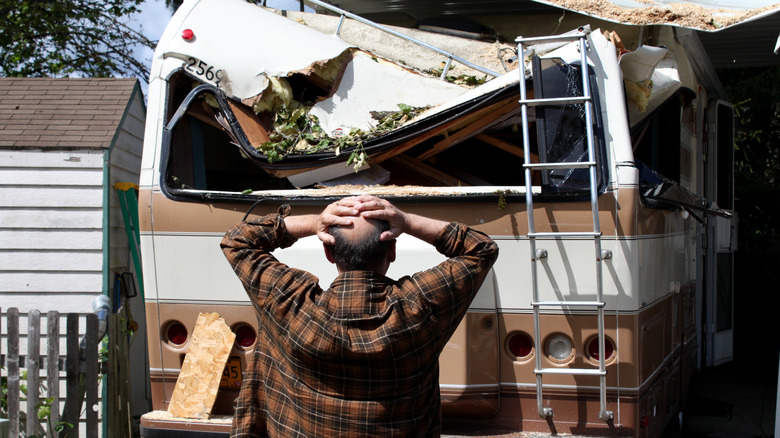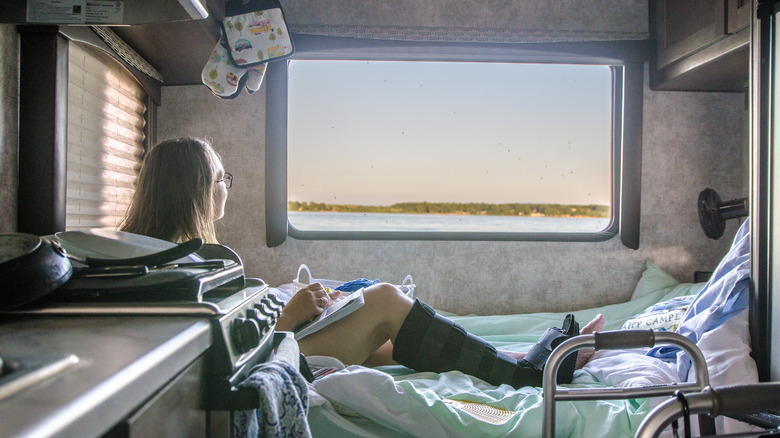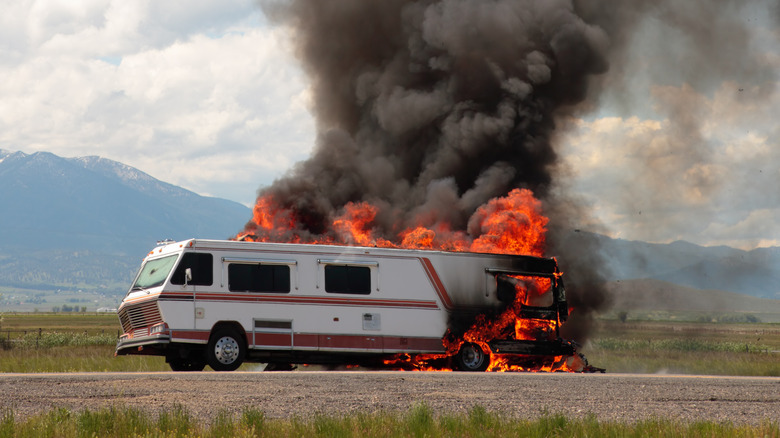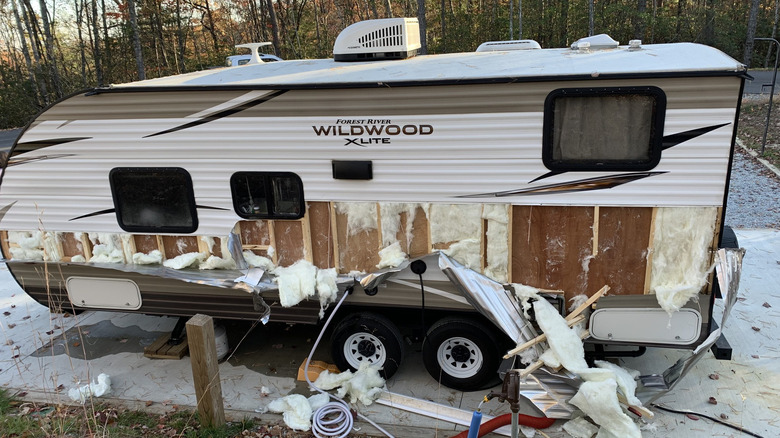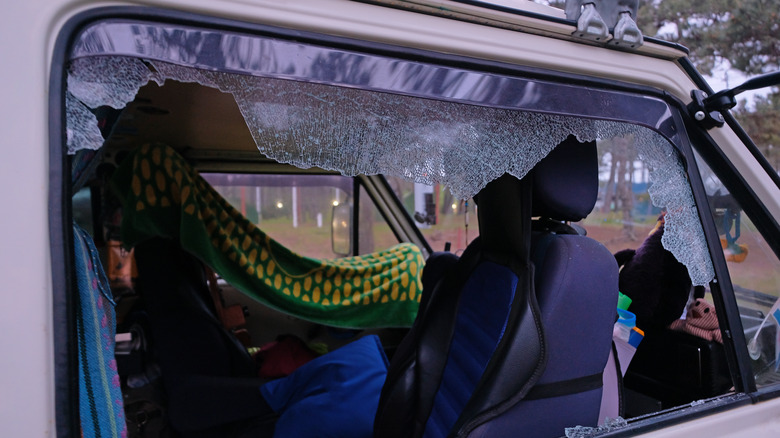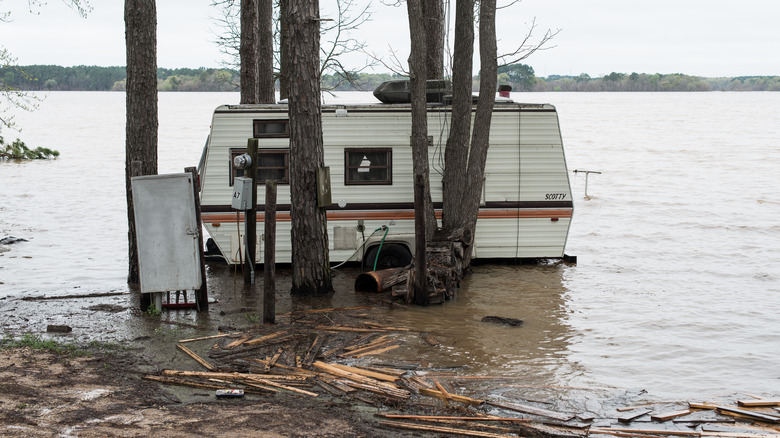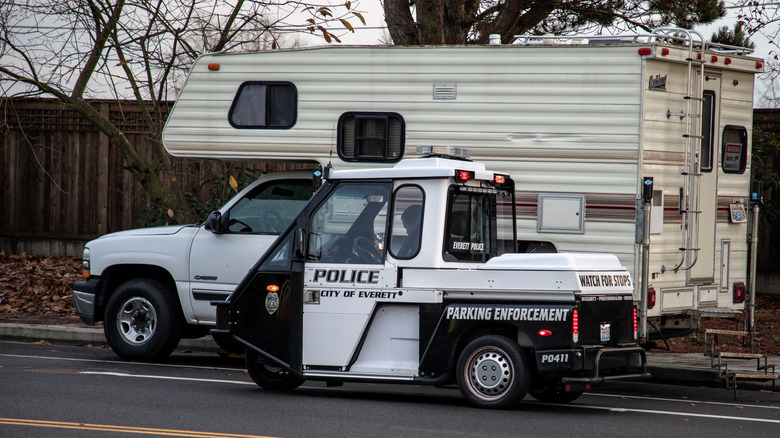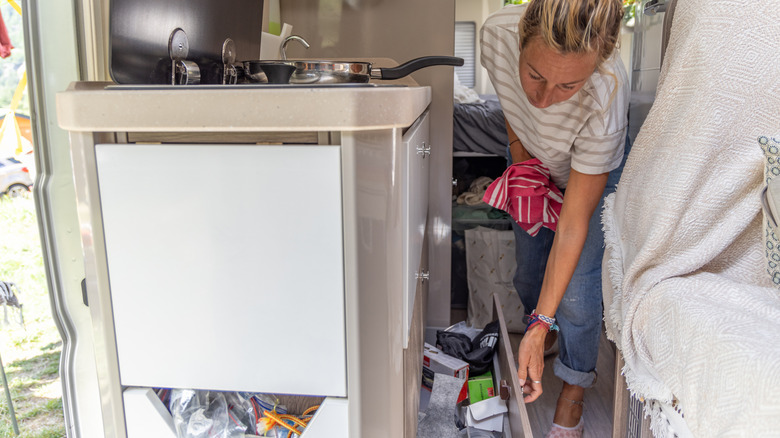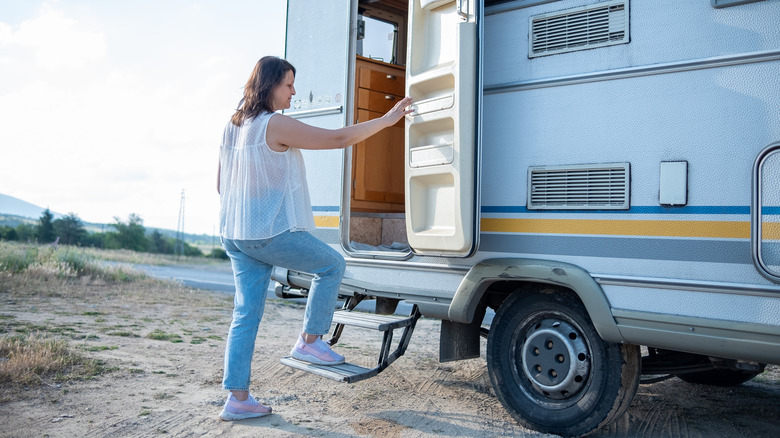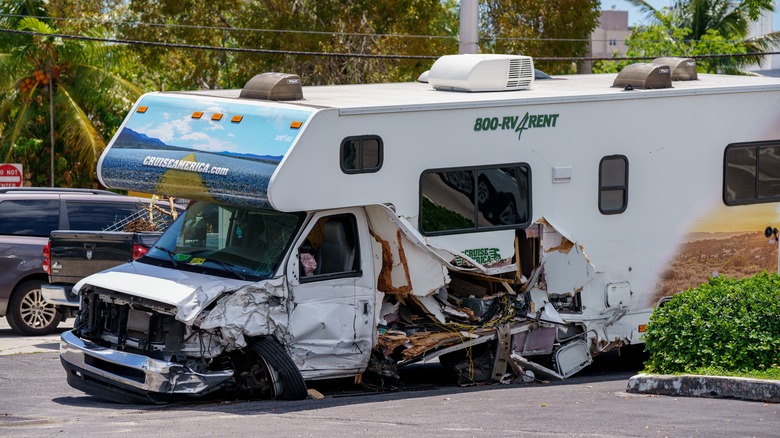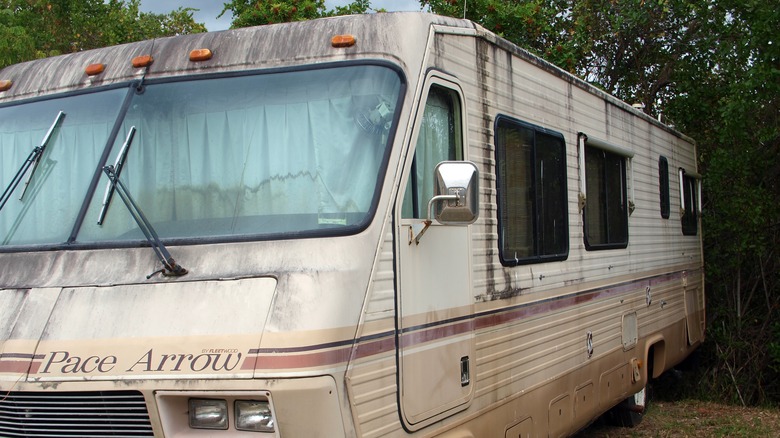People Don't Talk About The Most Dangerous Parts Of RV Living
It's easy to idealize RV life. Hitting the open road, camping out amid natural wonders, all while bringing the comforts of home wherever you go — what's not to like? Well, quite a lot.
Although RV travelers escape the monotony of occupying a stationary abode, they still have to deal with headaches like burglaries, fire hazards, and pest infestation, not to mention additional concerns including confrontations with surly truckers, appliances going airborne, and the occasional bear attack. Before joining the legions of RV explorers, it's important to know just what dangers you face when living on the road, and how to avoid the perils of going mobile. This can make the difference between thoroughly enjoying the most stunning routes for a U.S. road trip, or enduring a long haul of pain on the asphalt.
This article is informed by memories of mishaps experienced firsthand during journeys in a camper van stretching from British Columbia to Chiapas and Tijuana to Washington, D.C.. That includes several weeks exploring the most underrated stops on Route 66. Observations from a year of living and working at a beachfront RV resort also came in handy here. Hopefully you won't have to learn these lessons the hard way.
Medical emergencies
No matter where you're living, debilitating injuries and other physical calamities can happen anytime. In suburbia, if a household member experiences early signs of a stroke or heart attack, you likely have the luxury of rushing that person into your car and racing to a nearby hospital along familiar roads. This won't be the case when camped out in your RV many miles from civilization.
The logistics of your RV lifestyle play a big role here, too. If you have a separate travel trailer or fifth wheel, you can leave that behind and drive off immediately — but only if the towing vehicle is already detached. If traveling in a motorhome, and that's your only form of transportation, delays are more likely. It can take many valuable minutes to retract an awning and slide-out sections, and then put away myriad objects scattered throughout the living area, before starting up the engine and rushing to the nearest medical facility — and what if the person suffering from an urgent condition is the one who usually drives the RV? The response time will be slower if the operator of this oversized vehicle isn't comfortable behind the wheel.
Throughout your RV travels, remain aware of how to reach the closest community with a hospital or clinic. Before hitting the road, be proactive by getting full checkups, and make sure to have a properly stocked medical emergency kit on hand. Also, consider signing everyone in your group up for first-aid training.
The fire dangers of RVs
As horrible as house fires are, RVs can be fully engulfed in flames much more rapidly, and feature plenty of built-in ways to start a blaze. Many RVs carry tanks of both gasoline and propane — along with electrical outlets and highly flammable materials — so these mobile living quarters are especially prone to going up in smoke. Every year in the U.S., thousands of RV fires are reported, resulting in injuries and deaths.
The fire dangers inherent to RV living aren't limited to their interiors. If handled improperly, outdoor grills, campfires, and even tiki torches can spread flames into the RV. If a neighboring RV catches fire and you're parked too close, the blaze can easily jump to your rig. And while camping out in wooded areas, a fast-moving wildfire can rapidly encircle RVs.
Just like living in a house or an apartment, prevent fire catastrophes by installing smoke alarms. Make plans for evacuating every section of your RV as directly as possible, including through windows if the nearest exit is blocked by flames. Finally, though it's important to keep well-maintained fire extinguishers in your RV, if a flare-up is obviously severe, it's better to get as far away from the vehicle as possible than attempt putting out the blaze yourself — a tank of flammable liquid could explode at any moment.
RVs are prone to animal attacks
When parking your RV in nature, remember that you're definitely not the only living being making yourself at home there. In fact, you're intruding on the permanent residence of countless wild animals, and it's reasonable to expect that they'll come sniffing around to see what their new neighbors have to offer. Bear attacks are uncommon — but they do occur, as evidenced in the photo above posted on social media by North Carolina officials following a 2023 ursine assault at Gorges State Park. Meanwhile, other four-legged campsite visitors can include raccoons and skunks, not to mention zero-legged beasts that may slither beneath your motorhome.
All the usual camping tips for wild animal safety apply when exploring the great outdoors in your RV. Never encourage critters by feeding them, and always keep food in airtight containers so that its scent is less likely to draw unwanted dinner guests. Dispose of your trash regularly and responsibly, as food scraps can also attract varmints. Be aware of what wildlife is prevalent in any natural area that you visit by researching in advance, or stopping by the visitor center at state and national parks. And if you're bringing a pet along for the ride, keep your furry friend close by — a pooch may provoke passing creatures, and if small enough, a dog can become prey.
RV break-ins
Animals aren't the only potential invaders that RV campers need to be concerned about. In remote areas, robbers may see your motorhome as an easy target, given its windows. You may have an alarm installed, but if you're too far away to hear it, by the time you return to your RV the perpetrator could be long gone with your valuables — or even with your towing vehicle, if the burglar finds a spare key inside your trailer or fifth wheel.
It may be appealing to leave the world behind, but choosing well-populated RV campgrounds can help prevent this worst-case scenario from coming to pass. This is one of many good reasons to establish friendly relations with neighboring campers, as they can keep an eye out for suspicious characters around your motorhome. Nonetheless, keep your curtains drawn and doors locked when away from your RV, and if leaving the campsite unattended after dark, switch on an interior light so that thieves are more likely to think somebody's inside.
Severe weather
You may be accustomed to driving a car in bad weather, but taking on a heavy storm behind the wheel of a 40-foot RV is an entirely different experience. Wind gusts will buffet the huge surfaces of a motorhome, potentially causing drivers to lose control. Particularly powerful gales can flip an entire trailer on its side. And on snowy or icy roads, a heavy RV is highly vulnerable to skidding and fishtailing, especially if its tires are worn smooth.
Even when it's parked, your RV is susceptible to nature's forces. Stationary trailers can also be flipped in high winds, especially when slide-out sections are extended. Low-lying campgrounds are flooded during downpours. Winter storms may leave your RV snowbound for days, while melting snow causes water damage to interior walls.
There are steps you can take to mitigate the risk of severe weather, such as parking it in the direction of prevailing winds to minimize the surface area exposed to gales. However, your best bet is remaining updated on weather forecasts and being ready to pack up and go before storms head your way. In case of extreme weather events, like tornadoes, don't hesitate to abandon your RV and seek out solid shelter.
Boondocking badly
A cost-saving advantage of RV living is the ability to pull over in random places and spend the night for free — a practice called boondocking. However, for anyone who is careless about choosing a parking spot, boondocking can become a boondoggle. From being chased off private property to attracting law enforcement, uncomfortable consequences can result from boondocking badly.
It may seem that a truck stop is a surefire spot for vehicular sleeping — after all, truckers do it all the time. Well, this will usually work for small RVs that fit in a parking spot meant for a regular car, but anyone with an oversized motorhome who claims a large space designated for trucks may invoke the wrath of big rig drivers who feel entitled to that place. Even parking a mid-size RV in the regular lot may block traffic, leading truck-stop management to get involved.
Some superstores like Walmart and Cabela's allow RVs to park overnight in their massive lots, but other locations aren't so welcoming, so trust your instincts when it comes to this and other road trip sleeping hacks. Rest stops may allow overnight parking, but some only permit shorter visits, so look for signs with relevant rules. As for pulling over in a town for the night, many municipalities have laws banning public camping, so cops will quite possibly awaken you to offer a late-night crash course about local regulations.
Mechanical issues
An auto breakdown is awful when driving a car, but when stranded beside the road in a nonfunctional RV, your problems are multiplied. Not only will it be a challenge to get your rig towed, since a heavy-duty tow truck will likely be needed, but not every mechanic is equipped to repair RVs, and the nearest garage that is capable of the task might be quite a distance away. Even then, it may take awhile to order special parts. All of this means that a motorhome breakdown is likely to leave you broke.
When pursuing the RV lifestyle, practicing preventative maintenance pays big dividends. Learn how to check all fluid levels — engine oil, radiator coolant, etc. — and do so very regularly. Also look out for leaks; if you park on a spotless surface and see drops (or worse, shiny puddles) beneath your RV's motor the next morning, it's well past time to get an engine checkup. And pay particular attention to the status of your tires and brakes, especially if driving in mountainous terrain. If your brake pads catch fire, the blaze can quickly spread to the rest of your RV.
Carbon monoxide poisoning
RVs are loaded with potential sources of carbon monoxide poisoning, including propane-powered stoves, heaters, and refrigerators. Produced by burning almost any kind of fuel, carbon monoxide is an invisible and odorless gas that can rapidly build up in small spaces, like within a motorhome — and victims of this silent killer often aren't aware of its presence until it's too late. On average, around 400 people die from unintentional carbon monoxide poisoning (unrelated to fires) in the U.S. every year, so having a carbon monoxide detector in your RV is literally a matter of life and death.
When RV appliances are new and functioning perfectly, they're typically safe — but older propane-powered equipment can develop clogs that lead to carbon monoxide buildup. In addition to keeping motorhome appliances well maintained and making sure your carbon monoxide detector is functioning, play it safe by keeping windows open while cooking indoors, and never operate a gas-powered generator inside your RV. Signs of carbon monoxide poisoning include headaches, dizziness, weakness, and disorientation; get outside immediately if you feel any of these symptoms.
Improperly secured items
You may think that you've strapped down everything in your RV, but an unexpectedly sharp turn can send objects flying in your living space, ranging from sharp utensils to small appliances. This also applies to any passengers riding in the back of a motorhome without wearing seat belts. The latter problem is more easily solved — require passengers to buckle up when the RV is in motion, unless briefly stepping away from their seat, like when riding in an airplane. Inanimate objects aren't as inclined to follow the captain's instructions.
For this reason, loose objects in your RV need to be secured before you hit the road, and considerations of physics are crucial. Storage containers kept at floor level — such as what you get with this clever seating hack to open up space in your RV — are your best bet for holding anything heavy; the door to a higher cabinet may not remain closed if a weighty appliance suddenly slams against it from the inside. As for smaller items, consider using velcro tape or earthquake putty to stick them in place.
Running out of provisions
RVs can be seen as updated versions of the covered wagons used by pioneer families of American history. Of course, motorhomes are considerably more comfortable than the oxen-powered vehicles that our hardy ancestors traveled in, but some similarities remain. For example, in hinterlands far from the nearest town, if you don't have enough food to eat or clean water to drink, the situation can turn dire pretty quickly.
First of all, make sure to have all the gear you'll want for any camping adventure before even leaving your driveway. As for food and drink, it's pretty easy nowadays to restock provisions as you go; even rural communities are likely to have a small supermarket, so if you're unsure your supplies will sustain everyone through the foreseeable future, go ahead and stop into that gas station mini-mart and stock up.
However, our ancestors did have a distinct advantage when it came to fuel. Oxen could graze on grasslands to fill up their tanks, but if you run out of gas in a thirsty RV, you'll have to find your own way to the nearest station — quite possibly on foot — before carrying fuel back to your stranded ride. What's more, a standard two-gallon canister may not hold enough gas to power your RV back to civilization.
Tripping hazards
The metal fold-out steps below RV exterior doors are notoriously wobbly and slippery. These ladder-like stairs are already tricky to use when you're parked on pavement, but they become actual tripping hazards when occupying a campsite with bumpy ground below the doors, especially while carrying items in and out of the motorhome. There are plenty of reports about these steps malfunctioning as well — and eschewing them in favor of a cheap foldable step stool can also lead to falls and hospital visits.
The most obvious solution is to be extremely careful whenever entering or exiting the RV, though that's easier said than done when camping out long term. You can make the built-in steps a little safer by affixing carpet to the stair surfaces or using an adjustable step brace beneath the bottom rung, but buying or building a customized set of solid wooden steps to place below the RV doorway can be well worth the money and effort invested.
This is only one of many tripping hazards inherent in taking your motorhome to unfamiliar campgrounds (such as rocks, tree roots, and animal burrows), so make sure to carefully scope out the terrain surrounding your RV, and have ample light sources after dark to see where you're walking.
Driving difficulties
From low clearance underpasses to dangerously steep grades to ordinary traffic accidents, any number of driving hazards can become especially disastrous when they involve RVs. In the U.S., most states don't require RV operators to have any sort of special driver's license, and considering that some motorhomes are 40 feet long and can weigh up to 15 tons, this naturally raises questions about how qualified the average driver may be when behind the wheel of such a barreling behemoth. If you are that average driver, do everything you can to be as responsible as possible on the road.
Before setting out on an extended journey complete with distractions like bad weather and kids yelling in the back, take time to practice driving your RV in a safe and traffic-free environment so that you become accustomed to operating it, and can recognize blind spots in the rearview mirrors. Memorize the height of your motorhome, and don't take chances to see if you can squeeze through an underpass with an inch or two to spare. Most importantly, drive slow and easy at all times — and never even think about driving an RV after drinking alcohol; there's a bed in the back, so put the keys away and go sleep it off.
Infestation during storage
You probably have screens on your motorhome windows to keep bugs out, and you can use this easy hack to burn coffee grounds for mosquito-free camping. But many RV owners leave their rigs dormant in one spot for many months while storing them between vacations, giving critters plenty of time to figure out how to get inside. If you don't take proper precautions, don't be surprised to find entire colonies of spiders, cockroaches, or even bigger pests making themselves at home in your RV.
Pick your storage location carefully. Parking the RV right next to overgrown shrubbery in the wildest corner of your yard will provide plenty of branches for bugs to use as bridges to access the surface of your vehicle, in search of comfy shelter inside. If your motorhome is clear of bushes and trees, you can sprinkle borax around the tires — being the only part of the RV in contact with the ground — providing a barrier of protection against earthbound creepy-crawlies. Meanwhile, sealing up gaps can deter airborne insects.
Thoroughly clean the interior of your RV before storing it, making sure to clear out any food. Forgotten snacks can attract rodents, who may then chew on electrical wires for dessert, potentially causing malfunctioning parts and fire hazards. Also, mitigate mold growth by covering your RV with a tarp to keep moisture out, and use desiccant-based dehumidifiers.
